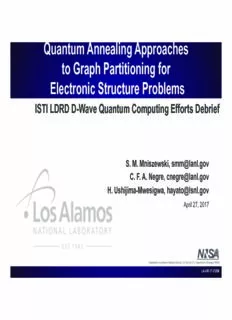
Quantum Annealing Approaches to Graph Partitioning for Electronic Structure Problems PDF
Preview Quantum Annealing Approaches to Graph Partitioning for Electronic Structure Problems
Quantum Annealing Approaches to Graph Partitioning for Electronic Structure Problems ISTI LDRD D-Wave Quantum Computing Efforts Debrief S. M. Mniszewski, [email protected] C. F. A. Negre, [email protected] H. Ushijima-Mwesigwa, [email protected] April 27, 2017 Operated by Los Alamos National Security, LLC for the U.S. Department of Energy's NNSA LA-UR-17-23580 NOTE: This is the lab Introduction color palette. • Motivated by graph-based methods for quantum molecular dynamics (QMD) simulations • Explored graph partitioning/clustering methods and implementations that run on the D-Wave – k-Concurrent graph partitioning into equal parts – k-Concurrent community detection using the modularity metric – Iterative multi-level graph partitioning with D-Wave refinement • Used sapi and hybrid classical-quantum qbsolv software tools • Demonstrated “proof of principle” results on example graphs and material electronic structure graphs • Results are shown to equal or out-perform current “state of the art” methods Graph partitioning/clustering implementations on the D-Wave. LA-UR-17-23580 NOTE: This is the lab Motivation color palette. • Next Generation Quantum Molecular Dynamics LDRD-DR (PI:AMN Niklasson) • Quantum-based models capture the making and breaking of covalent bonds, charge transfer between species of differing electronegativities, and long-range electrostatic interactions - reactions • Graph-based methods for quantum molecular dynamics (QMD) simulations A. M. N. Niklasson et al, Graph-based linear scaling electronic structure theory, J. Chem. Phys. 144, 234101 (2016). • Density matrix generated each timestep from many small sub-matrices (or sub-graphs) • Shown to be equivalent to traditional methods (ex. diagonalization) LA-UR-17-23580 NOTE: This is the lab Quantum Annealing on the D-Wave 2X System color palette. • Ising model formulation used for small graphs that are directly embeddable in the Chimera graph using sapi – Minimizes the objective function: O(h,J,s) = Σhs + ΣJ ss i i ij i j • Larger graphs are formulated as QUBOs for hybrid classical quantum qbsolv - 0/1 valued variables – Minimizing the objective function: O(Q,x)= ΣQ x + Σq xx ii i ij i j • Reduced qubit/coupler footprint achieved by thresholding and graph complement • D-Wave 2X Architecture – Fixed sparse graph G = (V,E) called the Chimera graph – 1095 qubits, 3061 couplers, with sparse bipartite connectivity – Chimera graph consists of a 12 x 12 array of 4 x 4 bipartite unit cells LA-UR-17-23580 NOTE: This is the lab Graph Partitioning - Description color palette. • Definition: • Given a graph G = (V, E) • V ~ nodes • E ~ edges (possibly weighted) • Goal: Partition V into k equal parts minimizing the number of cut edges between parts • Applications: – Graph-based QMD simulations - Used as initial solution for core-halo partitioning – Physical network design – VLSI design – Telephone network design (original application with algorithm due to Kernighan) – Load balancing - minimize total communication between processors – Sparse matrix-vector multiplication - Partition the rows of a matrix to minimize communication during matrix-vector multiplication LA-UR-17-23580 NOTE: This is the lab Graph Partitioning – Benchmarks and Random Graphs color palette. • Graphs partitioned: – Using sapi for small graphs (up to 45 vertices) – Using qbsolv for large graphs (> 45 vertices, up to 1000s) • Results comparison: minimize number of cut edges between parts – Quality • METIS • KaHIP (winner 10th DIMACS challenge) • Best known solution – Data • Walshaw benchmark archive (http://chriswalshaw.co.uk/partition/) • Random graph models (from NetworkX), e. g. Erdos-Renyi, PowerLaw graphs • Molecule electronic structure graphs from QMD simulations • Comparable to existing methods and sometimes better! LA-UR-17-23580 NOTE: This is the lab Graph 2-Partitioning Formulation color palette. • Exact Formulation – min xTLx, such that Σ x = n/2, x in {0,1} i i • QUBO – min xT (βL + α1 ) x – αn (Σx) + αn2/4, x in {0,1} 10,000 atoms nxn i i Water system • where • L ~ Laplacian matrix; 1 ~ all ones matrix nxn • α, β ~ penalty constants Density matrix (for QMD) METIS Partition k LA-UR-17-23580 NOTE: This is the lab Graph 2-Partitioning Results using qbsolv color palette. Walshaw GP benchmark graphs: Graph n best METIS KaHIP qbsolv add20 2395 596 723 760 647 data 2851 189 225 221 191 3elt 4720 90 91* 92 90 bcsstk33 8738 10171 10244* 10175 10171 *: not 0% imbalance LA-UR-17-23580 NOTE: This is the lab k-Concurrent Graph Partitioning – Multiple parts in parallel color palette. • Partition into k parts in parallel • Uses super-node concept • Unary embedding • k logical qubits per vertex • New formulation requires a kn x kn QUBO • Results in 1 of k qubits set on for each vertex • Similar to graph coloring problem Super-node Concept • Useful for graph partitioning and community detection LA-UR-17-23580 NOTE: This is the lab Graph k-Partitioning Formulations color palette. • QUBO Formulation 1 – Proof of Principle – Combines super-node concept with the 2-partitioning formulation and constraints on balanced part sizes and each node in 1 of k parts – Penalty constants: α (balancing), β (minimize cut edges) – Requires tuning of node weights and and coupler strengths for super-node – Resulting parts not always well-balanced • QUBO Formulation 2 – (k-1)n x (k-1)n QUBO – Combines super-node, balancing constraints on part sizes, and constraint on each node being in 1 of k-1 parts – Penalty constants: α (balancing), β (minimize cut edges), γ (each node in 1 part) – Results not always balanced, k-1 balanced parts and large kth part • QUBO Formulation 3 – kn x kn QUBO – Combines super-node with explicitly enforcing balancing constraints on part sizes, and constraint on each node being in 1 of k parts – Penalty constants, : α , β, γ – Results in balanced parts LA-UR-17-23580
Description: